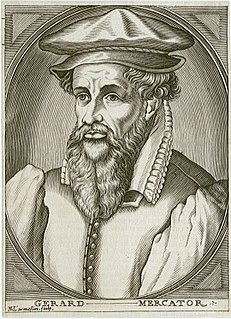 W
WFranciscus Haraeus, , was a theologian, historian, and cartographer from the Low Countries. He is best known for his history of the origins of the Dutch Revolt, written from a Catholic perspective but without polemical bias. He was one of the first cartographers to make thematic maps and globes.
 W
WGerardus Mercator was a 16th-century geographer, cosmographer and cartographer from the County of Flanders. He is most renowned for creating the 1569 world map based on a new projection which represented sailing courses of constant bearing as straight lines—an innovation that is still employed in nautical charts.
 W
WJan Nyssen is a Belgian physical geographer, and professor of geography at Ghent University.
 W
WAbraham Ortelius was a Brabantian cartographer, geographer, and cosmographer, conventionally recognized as the creator of the first modern atlas, the Theatrum Orbis Terrarum. Ortelius is often considered one of the founders of the Netherlandish school of cartography and one of the most notable figures of the school in its golden age. The publication of his atlas in 1570 is often considered as the official beginning of the Golden Age of Netherlandish cartography. He is also believed to be the first person to imagine that the continents were joined before drifting to their present positions.
 W
WGaspard van der Heyden was a goldsmith, engraver, master printer and builder of precision astronomical instruments including terrestrial and celestial globes from Leuven, Belgium. He was well known among the humanists in Leuven as well as among scientists and mathematicians.
 W
WPhilippe Vandermaelen (1795–1869) was a Belgian geographer.
 W
WAlphonse-Jules Wauters (1845–1916) was a Belgian art historian, geographer, and magazine editor.